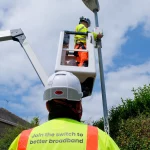UK Government Moot Using Public Sector Networks to Help Boost Broadband
The United Kingdom is crisscrossed by a variety of different Public Sector Networks (PSN), which are used to supply councils, Network Rail, universities (JANET), security / military services and so forth. But many of these networks are not fully utilised and the Government intends to harness this to help improve broadband for homes and businesses.
The idea of using PSNs to help improve broadband for non-public sector areas is nothing new and we have already seen some examples of it happening before. The Government has now commissioned a review of their PSNs, which gobble around £1.5bn of spending each year, in order to see if they could make better use of them.
Advertisement
Francis Maude, Minister for the Cabinet Office, said:
“In a world that is becoming digital-by-default and mobile-first, citizens are increasingly reliant on access to high speed networks to communicate, work and access essential public services wherever they are.
Last summer we launched a review into the digital and telecommunications infrastructure owned or leased by the public sector to help us take full advantage of existing capacity [and] today we are publishing the initial results of this landscape review.
These maps and data are a first step into increasing transparency and setting out how we will use our publicly-owned networks more effectively. In the past hundreds of millions of pounds of taxpayers’ money was spent building these networks – this Government believes they should be put to full use for all the public.
This is a great opportunity. We want to take full advantage of this existing capacity, avoiding wasteful duplication when buying additional resource.”
As part of the first stage of this review the Cabinet Office has identified a set of maps and data, which they’ve published today, to aid their work and collaboration on getting better connectivity for the public. Some of opportunities being investigated, such as using the infrastructure at wind farms to support rural broadband networks, are highlighted below.
Sample of Alternative PSN Opportunities
• Jisc, the parent organisation for the Education & Research Network (JANET) is bidding to join the Public Services Network. This would open up JANET capabilities and technologies across the public sector and avoid duplicating investment and commercial provider charges;
• The Home Office are exploring the possibility of minimising the number of connections into Ports and Airports; and
• Exploiting network cabling supporting wind farms to provide improved rural connectivity. Infrastructure UK will explore the possibility of using this infrastructure to provide services such as broadband for remote communities, and mobile backhaul, working with DECC and DCMS.
At this stage there’s not a lot of meat on the bone and indeed the Government must be mindful that the reason some public sector networks have so much extra capacity is because they’re planning for the future (e.g. Network Rail’s on-going fibre optic upgrade will have massive capacity and most of it will go unused, at least for the initial few years).
Put another way, it might sometimes be unwise to clog all of that capacity up with traffic from consumer broadband as you’d end up spending even more in the future to retain what you need for the public services. On the other hand there are certainly opportunities here and it may often be cheaper to upgrade an existing infrastructure than to build new cable to some of the same areas.
Lest we not forget that part of the Government’s recent agreement with mobile operators to improve geographic coverage also involves allowing the operators to harness PSNs by installing base stations and masts on publicly owned buildings and land. This is one example of efficient PSN use. The first map is published below, although it’s very basic.
Advertisement

Mark is a professional technology writer, IT consultant and computer engineer from Dorset (England), he also founded ISPreview in 1999 and enjoys analysing the latest telecoms and broadband developments. Find me on X (Twitter), Mastodon, Facebook, BlueSky, Threads.net and Linkedin.
« DEFRA UK Report Calls for 10Mbps Universal Broadband Commitment


















































Comments are closed